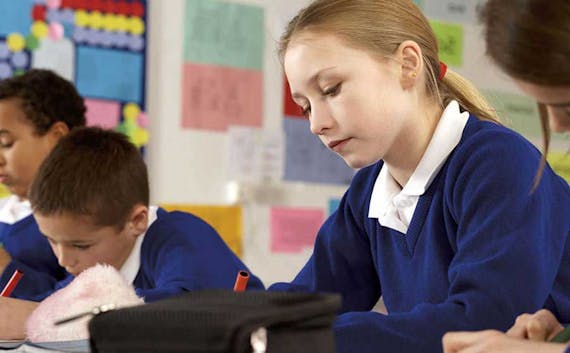SATs Scores Explained
As a parent, it can be difficult to know how to understand your child's SATs results.
Terms like 'scaled score', 'raw score' and 'expected standard' as well as acronyms like 'GDS' and 'EXS' can be mentioned alongside your child's school report.
If your child is taking their KS1 SATs or KS2 SATs and these terms have you a little confused then read on!
Table of Contents
How are SATs marked?
Children take their SATs (Standard Assessment Tests) in May. The tests are then marked and schools are notified of their pupil's results before the end of July.

Key Stage 1 SATs (in Year 2) and Key Stage 2 SATs (in Year 6) are marked differently.
Key Stage 1 SATs
KS1 SATs in English Reading and Maths and marked by a child's classroom teacher. Their teacher marks their SATs papers and submit each child's exam scores into a secure online portal.
Some papers may be sent off to the Standards and Testing Agency (STA) to be moderated to ensure that all marking is consistent.
Key Stage 2 SATs
KS2 SATs in English Reading, Maths and Grammar, Punctuation and Spelling (GaPS) are marked externally.
After completing all KS2 SATs exams, every paper is securely boxed and sent to the STA, whereby they are sorted and distributed to a large team of exam markers.

KS2 Science and Writing SATs
KS2 SATs in Science and Writing are no longer formal exams and are instead a school's own informal, internal tests. These tests are called teacher assessments and every teacher assessment is set and marked by their classroom teacher.
Until 2019 there used to be a KS2 Science SATs sampling paper that was sat by a minority of pupils every two years to assess national standards. That was due to be used in 2020 and again in 2022 before the STA announced its retirement.
When do parents get their child's SATs scores?
Headteachers are notified of all their pupils results in July. It is then up to each primary school to decide how and when they distribute the information to parents.

These results are only provisional and they may change, subject to additional checking by schools and teachers.
For KS2 SATs scores, children's individual marks are often sent home as part of their end-of-year report. For KS1 SATs, it's quite unlikely that marks will be reported to parents and hence parents may need to ask.
School League Tables
In December, each school's KS1 and KS2 SATs scores are published in the Department of Education's 'primary school league tables' or 'national SATs results tables', comparing the SATs performance of all primary schools.
Parents can then easily browse and compare recent national SATs results, local authority SATs results and individual school SATs results to help them choose a primary school for their children.
What do the SATs results mean?
Instead of using just exam marks or a raw score, SATs results are reported as a scaled score. This replaced the national curriculum levels system that was in place until 2016.

What are raw scores and scaled scores?
A child's raw score is simply the total number of marks they get in a test (e.g. 34 out of 50 or 42 out of 75) while a scaled score (sometimes called a standardised score) is a raw score that has been adjusted and converted to a standardised scale.
Different Questions = Different Difficulty
Every year, children in Year 2 and Year 6 take SATs tests. These tests may well have the same specification, structure and timings but they have different questions. Hence, the difficulty of each year's test may vary. This can make comparing children's marks between different years largely meaningless.
Why Scaled Scores?
To easily compare exam marks from different years, testing agencies across the world have developed a system called scaled scores.
A scaled score is a representation of the total number of correct questions a pupil has answered, converted into a consistent and standardised scale, thus allowing easy and accurate comparisons of performance over time.
In layman's terms, a scaled score lets us compare past exam performance by fiddling the marks so that the difficulty of a past paper isn't a problem!
The best way to feel comfortable with scaled scores is to look at those from past years. We suggest parents look at the 2022 scaled scores for KS2. Here you'll find our tables which show that (again, for example) the Reading paper required 29 marks (out of a possible 50) to achieve the 'expected standard'. Thus, the pass mark for SATs 2022 for the Reading paper was 29/50.

Scaled Score Conversion Tables
Once all the SATs tests have been marked, the STA moderates all raw scores and generates scaled score conversion tables.
Pupils scoring at least 100 will have met the expected standard on their test.
Scaled Scores Change Every Year
Remember, since the difficulty of each test may vary between years, the number of raw score marks needed to achieve a particular scaled score may also change.
For example, if the overall difficulty of a test decreases compared to previous years, The raw score required to meet the expected standard will increase. Similarly, if the test is more difficult, The raw score required to meet the expected standard will decrease.
As the scaled score for each paper is carefully calculated, there is no 'average scaled score'. The only reliable way to use scaled scores is for children to take a particular test and use that particular test's scaled scores to see whether they have reached the expected standard.

Key Stage 1 SATs scaled scores Explained
For Key Stage 1 SATs, children will receive a scaled score in English Reading and Maths. They may also receive a scaled score in English Grammar, Punctuation and Spelling (GaPS) although, as this is an optional paper, they may not.
KS1 SATs scaled scores Range
-
If a child's scaled score is at least 100 they will have met the expected standard (or expected level).
-
The lowest scaled score that can be awarded on a KS1 test is 85. The highest scaled score is 115.
-
A pupil awarded a score of 99 or less has not met the expected standard in the test.
Past KS1 SATs Scaled Scores
You can view and download previous Key Stage 1 SATs scaled scores on our dedicated KS1 SATs Papers page or by viewing that particular year's SATs:
Key Stage 2 SATs scaled scores Explained
For Key Stage 2 SATs, children will receive a scaled score in English Reading, Maths and English Grammar, Punctuation and Spelling (GaPS).
KS2 SATs scaled scores Range
-
If a child's scaled score is at least 100 they will have met the expected standard (or expected level).
-
The lowest scaled score that can be awarded on a KS2 test is 80. The highest scaled score is 120.
-
A pupil awarded a score of 99 or less has not met the expected standard in the test.
Parents can expect to be told their child's raw score and scaled SATs scores.

Past KS2 SATs Scaled Scores
You can view and download previous Key Stage 2 SATs scaled scores on our dedicated KS2 SATs Papers page or by viewing that particular year's SATs:
KS2 SATs Outcome Codes
Together with their scaled scores and raw scores, each score is also given a KS2 SATs outcome code. These codes are listed below:
-
AS: The pupil has achieved the expected standard.
-
NS: The pupil has not achieved the expected standard.
-
A: The pupil was absent from one or more of the test papers.
-
B: The pupil is working below the level assessed by the KS2 SATs.
-
M: The pupil missed the test.
-
T: The pupil is working at the level of the tests, but is unable to access them (this could be due to all or part of a test not being suitable for a child with particular special educational needs (SEN).
KS2 Teacher Assessment Results
In addition to the KS2 SATs results, children also get teacher assessment result codes for Reading, Writing, Mathematics and Science.
This may seem strange but it is a required element of a child's school assessment. The full list of codes are as follows:
-
GDS: The pupil is working at greater depth within the expected standard. This is reserved for writing assessments only.
-
EXS: The pupil is working at the expected standard.
-
WTS: The pupil is working towards the expected standard.
-
HNM: The pupil has not met the expected standard. This is used for reading and maths assessments only.
-
PKG: This stands for pre-key stage, growing development of the expected standard. This means that the pupil is working at a level lower than expected.
-
PKF: This stands for pre-key stage, foundations for the expected standard. This means that the pupil is working at a level that is significantly lower than the expected.
-
BLW: The pupil is working below the pre-key stage standards, which is the lowest level of attainment.
-
A: The pupil was absent.
-
B: The pupil was disapplied. This means that they have not been tested at the KS2 level.
What is a good Year 6 SATs Score?
Anything above 100!
Parents should be happy if their child is working at the expected standard and over the moon if they're working at greater depth!
What's the SATs Highest Score?
The highest possible SATs score is 115 for KS1 SATs and 120 for KS2 SATs.
Are KS2 SATs scaled scores used by Secondary Schools?
Yes, scaled SATs scores are reported to every child's anticipated secondary school.

How are KS2 SATs Scores used by Secondary Schools?
Secondary schools often use children's SATs scores to help them stream new Year 7 entries in English and Maths.
However, every secondary school is likely to use its own methods to do stream pupils and hence SATs scores, teacher assessments and other information available from a child's teacher reference will likely be used alongside a secondary school's own internal school assessments (e.g. Year 7 CATs, teacher assessments and other cognitive ability tests).
Regardless of how secondary schools use a child's SATs scores, a strong score can work wonders for their confidence as they start the next step of their education in secondary school.
What about other primary school years?
Children are likely to sit informal SATs practice papers in Year 3, Year 4 and Year 5 to help prepare them for formal primary school tests and form part of a school's progress scores.
Regular assessments throughout Year 3, Year 4 and Year 5 help schools track their pupil's attainment before the KS2 SATs and hence track whether or not they're achieving the expected standard.
As these are only internal tests, there are no scaled scores and parents are unlikely to receive these test raw scores.
FAQ
What is a good SATs score?
Anything above a scaled score of 100!
What score is a pass in SATs?
Again, anything above a scaled score of 100!
